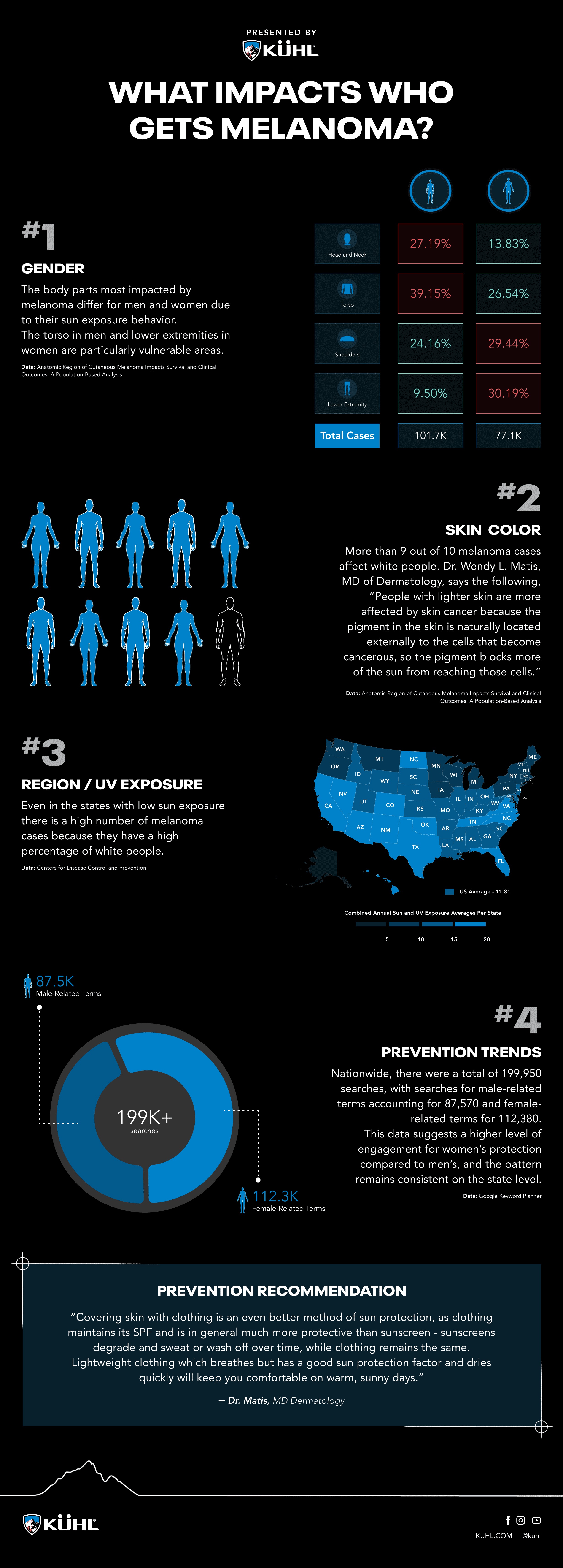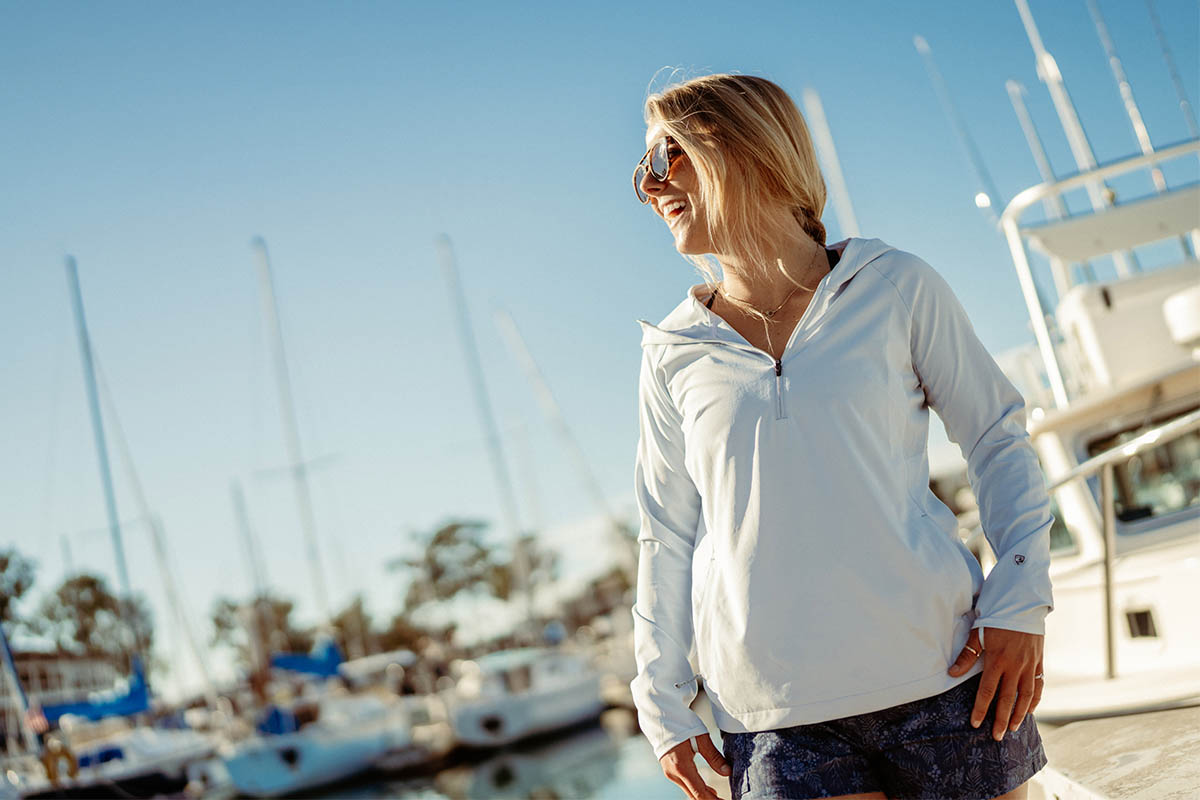- 1. Key Findings
- 2. Presenting the Findings: Melanoma Cases in the U.S.
- 3. Presenting the Findings: Sun Protection Interest in the U.S.
- 4. Presenting the Findings: Body Parts Most Affected By Melanoma
- 5. How UPF clothing plays a role in prevention?
- 5.1. How is UPF clothing rated?
- 5.2. What is UPF rating?
- 5.3. KÜHL’s approach to UPF clothing
- 6. What are the risk factors for melanoma?
- 6.1. Ultraviolet Light Exposure
- 6.2. Skin Color
- 6.3. Age
- 6.4. Lack of Sunscreen Use
- 7. Tips to prevent sun damage
- 7.1. Takeaway
- 8. Men, It’s Time to Take Action
- 9. Methodology
- 9.1. Data collection
- 9.2. Data analysis
- 9.3. Disclaimer

The Surprising Truth About Melanoma in Men
Table of Contents [Show]
As we dive into the hottest months and plan to spend even more time outdoors, we’d like to discuss a topic that often takes a backseat in our summer preparations—skin health. The American Cancer Society estimates that more than 100,000 Americans will be diagnosed with invasive melanoma in 2024, with about 59,000 cases in men and about 41,000 cases in women. Out of those cases, about 5,000 men and about 2,800 women will die from it.
But how many Americans care about sun protection? What drives this gender disparity in melanoma diagnoses, and why are mortality rates higher in men? Do differences in preventive behaviors play a significant role in the gender disparity?
To answer these questions, we gathered four years of data from the Centers for Disease Control and Prevention (CDC) and conducted a comprehensive analysis of melanoma case numbers and mortality rates. Additionally, we examined the body parts most frequently affected and analyzed the number of Google searches related to sun-protective clothing.
We then asked Dr. Wendy L. Matis, MD, of Dermatology at Matis Dermatology in Salt Lake City, to share her specialist opinion on the findings and give some tips on how to better stay protected against sun damage.
Key Findings
- 36.48% more men than women in the US were diagnosed with melanoma, and the mortality rate from melanoma among men was 61.74% higher compared to women. This shows that men are more impacted by skin cancer.
- There are 25.16% fewer Google searches for men-related sun protection terms than women-related terms. This indicates that men have a lower interest in skin cancer prevention, which may contribute to higher rates of melanoma diagnosis and melanoma mortalities.
- The body parts most impacted by melanoma differ for men and women, indicating that clothing choices significantly influence melanoma risk. The torso in men and lower extremities in women are particularly vulnerable areas, highlighting the need for targeted protection.

Presenting the Findings: Melanoma Cases in the U.S.
The United States saw a significant gender disparity in melanoma cases and mortality rates between 2016 and 2020. During this period, a total of 248,217 men were diagnosed with melanoma, compared to 171,638 women, revealing a difference of 76,579 more cases in men. Furthermore, the mortality rates underscore this disparity: 26,777 men died from melanoma, which is 12,693 more than women.
Let's delve deep into the numbers. The state-by-state breakdown of melanoma cases and mortality rates showed interesting patterns and disparities in diagnosis and outcomes. The top five states in the US with the highest percentage of melanoma cases per population from 2016 to 2020 are as follows:
- Vermont: 0.048% of people had melanoma (1,503 total cases – 843 men, 660 women)
- Minnesota: 0.041% of people had melanoma (11,595 total cases – 6,411 men, 5,184 women)
- New Hampshire: 0.041% of people had melanoma (2,749 total cases – 1,613 men, 1,136 women)
- Maine: 0.037% of people had melanoma (2,499 total cases – 1,344 men, 1,155 women)
- Utah: 0.036% of people had melanoma (5,736 total cases – 3,287 men, 2,449 women)
The high number of cases does not necessarily indicate a rise in melanoma prevalence but rather shows a positive trend towards skin screenings as a result of increased public awareness of skin cancer. Mortality data supports this statement. Over the past decade, the trend in melanoma mortality has been relatively stable, with a noticeable decline beginning in 2014. Here’s a breakdown of the top five states with the highest number of melanoma-related deaths per population:
- West Virginia: 0.0038% of people died (346 total deaths – 211 men, 135 women)
- Wyoming: 0.0038% of people died (110 total deaths – 72 men, 38 women)
- Maine: 0.0036% of people died (238 total deaths – 147 men, 91 women)
- New Hampshire: 0.0035% of people died (237 total deaths – 155 men, 82 women)
- Delaware: 0.0034% of people died (164 total deaths – 109 men, 55 women)
The numbers indicate that men consistently experience higher mortality rates from melanoma nationwide and across the states, highlighting a significant gender disparity.
Presenting the Findings: Sun Protection Interest in the U.S.
To gauge public engagement with preventive measures, we examined Google search data related to sun-protective clothing across the United States, from May 2020 to April 2024.
Nationwide, there were a total of 199,950 searches, with searches for male-related terms accounting for 87,570 and female-related terms for 112,380. This data suggests a higher level of engagement for women’s protection compared to men’s, and the pattern remains consistent on the state level.
These numbers suggest a positive correlation between the high count of melanoma diagnoses and preventive behavior. However, they also highlight a concerning trend: despite being more affected by melanoma, men engage less in searching for sun protection measures compared to women.
Looking at the study published in the Journal of the American Academy of Dermatology, we saw the same gender disproportion in applying sunscreen. Among the 4,033 participants, sunscreen usage was as follows:
- 18.1% of men and 42.6% of women used sunscreen on their face.
- 19.9% of men and 34.4% of women used sunscreen on other exposed skin.
- 14.3% of men and 29.9% of women used it on both face and other exposed skin.
The disparity in sunscreen application rates among different body areas in both genders highlights a potential gap in protective behaviors that could influence melanoma risk. These findings lead us to look into how these behaviors might correlate with the actual occurrence of melanoma across different regions of the body.
Presenting the Findings: Body Parts Most Affected By Melanoma
To see if the discrepancies in melanoma cases and mortality rates are driven by behavioral differences, we analyzed data from a cross-sectional study involving 178,892 cases to identify which regions of the body are most frequently affected by melanoma.
From 101,761 men melanoma cases:
- 39.15% had it on their torso.
- 27.15% had it on their head and neck.
- 24.16% had it on their upper extremities (includes arms, wrists, hands, and shoulders.)
- 9.49% had it on their lower extremities (includes hips, thighs, knees, legs, ankles, and feet.)
From 77,131 women melanoma cases:
- 30.19% had it on their lower extremities.
- 29.43% had it on their upper extremities.
- 26.55% had it on their torso.
- 13.83% had it on their head and neck.
Analyzing the data on melanoma cases and the body parts most affected reveals a clear link between clothing choices and melanoma risk, confirming the CDC’s statement that wearing sun-protective clothing can reduce harmful exposure to UV.
The data shows that men most frequently develop melanoma on the torso (39,838 cases), a common site of sun exposure when shirts are removed, as often seen at beaches, pools, or during sports. For women, the lower extremities (23,287 cases) and upper extremities (22,704 cases) are the most affected areas, reflecting common clothing styles such as skirts, shorts, and sleeveless tops that leave legs and arms exposed to the sun.
Dr. Matis says, “Sun exposure most likely determines the different body patterns of skin cancer incidence in men and women. Women commonly keep their shirts on when outdoors and have their scalp covered with hair, so those body parts are less likely to develop skin cancer than in men who often go shirtless and have either short haircuts which are not protective or have hair loss. Women tend to expose their legs more often wearing skirts or shorts and also may try a bit more to get tan legs, which may lead to women having a higher incidence of melanoma on their legs.”
UPF clothing, therefore, provides a practical solution to significantly reduce the risk of melanoma. This is especially important considering the ease with which UPF clothing can be integrated into your daily routine, offering both style and essential sun protection.

How UPF clothing plays a role in prevention?
UPF clothing is one of the most straightforward and effective ways to prevent melanoma, besides sunscreen. It serves as a physical barrier, blocking ultraviolet (UV) radiation from reaching the skin. Unlike sunscreen, which requires regular reapplication and may not cover all exposed areas effectively, sun-protective clothing offers consistent protection as long as it covers the skin. UPF (Ultraviolet Protection Factor) clothing is specifically designed to provide this protection and has been scientifically rated to block a certain percentage of UV rays.
How is UPF clothing rated?
To ensure the effectiveness of UPF clothing, the fabrics used undergo rigorous testing. During these tests, the fabric is exposed to a UV light source simulating the sun's rays. A sensor placed beneath the fabric then measures the amount of UV radiation that penetrates it. These measurements are used to calculate the UPF rating, ensuring that the clothing meets specific standards and provides reliable protection against UV exposure.
What is UPF rating?
The UPF rating indicates the level of sun protection provided by a piece of clothing. The higher the rating, the greater the protection:
- UPF 15 to 24: Good protection, blocking 93% to 96% of UV radiation.
- UPF 25 to 39: Great protection, blocking 96% to 97.4% of UV radiation.
- UPF 40 to 50+: Excellent protection, blocking at least 97.5% to 98%+ of UV radiation.
KÜHL’s approach to UPF clothing
The problem that persists is that the best clothing to block the sun's harmful rays isn’t always the most comfortable to wear while being active outside. The design team at KÜHL says, "Making clothes that protect you from the sun is standard. What makes KÜHL different is our relentless attention to detail in designing a UPF collection with fabrics that keep you cool, comfortable, and stylish."
The team achieves this result through choosing fabrics that are ultra-soft, utilizing fibers like nylon that have cooling properties and using strategic body mapping to create UV protection where you need it and breathability where you want it.

Product shown: Bandita™ 1/2 Zip Pullover and Kruiser™ Getaway Short.
What are the risk factors for melanoma?
Ultraviolet Light Exposure
Ultraviolet light, a type of electromagnetic radiation, can cause skin damage when it comes from natural (sunlight) or man-made sources. According to the American Cancer Society, UV radiation is categorized into three types:
- UVA: These rays make up about 95% of the UV radiation reaching the ground. They can damage skin cells, cause aging, and contribute to some skin cancers.
- UVB: Comprising the remaining 5%, these rays damage the DNA in skin cells, leading to sunburns and are primarily responsible for most skin cancers.
- UVC: The most potent of the three types, UVC rays mostly get absorbed by the ozone layer and thus rarely reach the ground, although they are present in man-made sources like welding torches and tanning beds.
Given enough time and accumulation, UV rays can cause serious trouble like sunburns, blisters, blemishes, and melanoma, among other skin cancers.
Skin Color
One of the significant risk factors for melanoma is skin color. Our analysis shows a link between the percentage of the white population and the incidence of melanoma cases. Specifically, as the proportion of the white population in an area increases, there is a notable increase in melanoma cases.
For instance, even in the states with low sun exposure, there is a high number of melanoma cases because they have a high percentage of white people. This indicates that people with light skin tones seem to be more at risk to get melanoma.
Dr. Matis explains, “People with lighter skin are more affected by skin cancer because the pigment in the skin is naturally located externally to the cells that become cancerous, so the pigment blocks more of the sun from reaching those cells. So, people with more pigment have more natural protection from the sun-induced genetic damage and mutations that progress over time into skin cancer. When people with more natural color in their skin do get skin cancer, it is more likely to occur on body areas less protected by pigment, such as the lips, nail beds, palms and soles.”
Even if lighter skin people seem to be more impacted by this skin cancer, melanoma does impact people with all skin types. The common misconception that melanoma does not affect people of color is tragically debunked by the death of musician Bob Marley, who succumbed to melanoma that began under his toenail at age 36.
Age
Melanoma death rates increase with age and are higher among men than women, according to the CDC. Additionally, one study shows that men aged 15 to 39 are 55% more likely to die from melanoma than women in the same age group. This discrepancy is partly due to melanomas that run in families, which may occur at a younger age, highlighting the need for early detection and preventive measures across all ages.
Lack of Sunscreen Use
Sun exposure accumulates daily, not just during outdoor activities or activities traditionally associated with high sun exposure like swimming or sunbathing. Regular daily use of sunscreen with SPF 15 or higher has been proven to reduce the risk of developing melanoma by 50%, when used as directed, however, as mentioned above, men are more reluctant to apply sunscreen.
Dr. Matis chimes in, saying, “The increased incidence of skin cancer in men is likely at least partially due to behavioral factors — women are more likely on average, in my experience, to use sunscreen regularly, to reapply sunscreen while outdoors, to cover their skin with clothing and to limit their outdoor hours. This may partially be because women are often more concerned than men about aging and as sun exposure is the major cause of premature aging of the skin, women pay more attention to sun exposure. Also, women tend to tolerate applying lotions and creams to their skin better than men do, which I think is cultural.”
While sunscreen use remains crucial for protecting areas not covered by clothing, there are also other things we can do to protect our skin from UV damage.
Tips to prevent sun damage
We’ve asked Dr. Matis to share some professional tips on how we could prevent sun damage when enjoying the outdoors:
- I recommend that everyone wear sunscreen every day on exposed skin such as face, neck and hands. Unfortunately, even the sun that comes through glass (UVA) contributes to skin cancer, so working in an office with windows, driving in a car, sitting in a classroom with a bank of windows, etc, are all times that those areas should be protected by sunscreen.
- When outdoors, it's important to cover exposed areas with sunscreen and reapply every 2 hours, as the higher energy UVB rays can burn the skin and also can break down the sunscreen ingredients, necessitating re-application.
- Covering skin with clothing is an even better method of sun protection, as clothing maintains its SPF and is in general much more protective than sunscreen - sunscreens degrade and sweat or wash off over time, while clothing remains the same. Hats and long sleeves, and even sun gloves and tights, are great ways to protect the skin while enjoying time outdoors. The advantage of clothing is that once you have it on you don't need to think about it again. Lightweight clothing which breathes but has a good sun protection factor and dries quickly is my best outdoor clothing recommendation for warm, sunny days.
- I also recommend scheduling outdoor activities during lower risk times (before 10 AM and after 4 PM) when possible. Doesn't work for alpine skiing, but is great for biking, hiking, tennis, etc. Even in the early morning and evening sun protection is still important, but easier to do (cooler temps in general) and more effective as the UVB rays are less strong.
Takeaway
- Seek Shade: Staying in the shade is one of the easiest ways to reduce UV exposure.
- Protective Clothing: Wear long-sleeved shirts, long pants, or leggings to cover the skin. Opt for light, tightly woven fabrics for better protection. Look for clothes with a UV protection factor (UPF) label, indicating the level of UV protection provided. A hat with a broad brim offers additional protection for the face, ears, and neck.
- Sunscreen: Slap on a broad-spectrum sunscreen with an SPF of 30 or higher. Apply generously and reapply every 2 hours, especially after swimming or sweating.
- Peak UV Hours: Avoid the sun between 10 AM and 4 PM when UV rays are strongest.
- Environment Factors: Be extra cautious near reflective surfaces like office windows or water, sand, and snow which intensify UV exposure.
- Sunglasses: Wear sunglasses that block 99% to 100% of UVA and UVB rays.
- Avoid Tanning Beds: Tanning beds and sun lamps emit harmful UVA and UVB rays and are linked to an increased risk of skin cancer.

Men, It’s Time to Take Action
This analysis highlights the urgent need for targeted interventions aimed at promoting sun-safe behaviors more, especially among men, including increased education on the importance of UPF clothing and regular sunscreen use. Closing this gender gap in sun protection could significantly reduce both the incidence and mortality rates of melanoma nationwide.
Methodology
Data collection
- We collected data on melanoma cases and deaths for all races and ethnicities, male and female, nationwide and on a state-by-state basis from the U.S. Cancer Statistics Data Visualizations Tool, provided by the CDC. The data spans from 2016 to 2020, which is the most recent period available with separate figures for males and females in each state. As there was no incidence data available for Indiana and Nevada, we excluded the two states from the study.
- From the same source, we obtained population data, broken down by gender for each state during the same period.
- We gathered data on the body parts and the races most affected by melanoma from the study "Anatomic Region of Cutaneous Melanoma Impacts Survival and Clinical Outcomes: A Population-Based Analysis", published in the National Library of Medicine.
- We used SEMRush to create two lists of popular search terms related to sun protection clothing, one for men and one for women. The men's list included terms like "UPF clothing for men," "men's sun protection clothes," and "men's UV hoodie.". Additionally, the women's list included terms such as "UPF clothing for women," "women's sun protection clothes," and "women's UV hoodie."
- Next, we used Keyword Planner to determine the search frequency for each term in every state between May 2020 - April 2024. We then summed the search totals for all terms to calculate an overall score for each state to determine the male and female sun protection habits. The data is accurate as of May 2024. We chose to focus only on searches for sun protection clothing because terms like "sunscreen" typically yield general results on Google that are not gender-specific. For sunscreen usage data, we used the study "Patterns of sunscreen use on the face and other exposed skin among US adults", published in the Journal of the American Academy of Dermatology.
- We collected data on the annual average daily dose of UV irradiance and annual average sunlight exposure measured for 2016-2020, from the Centers for Disease Control and Prevention - National Environmental Public Health Tracking Network.
Data analysis
- To assess gender disparity in melanoma diagnoses, as well as identify the states with the highest melanoma cases and deaths, we analyzed the number of cases and deaths by gender across the US and then in each state. We then compared these numbers to the population of each state to determine the exact percentage.
- To determine the interest in sun protection measures, we analyzed the sun protection searches by gender across the US.
- To determine the difference in melanoma spread on male and female body parts, we calculated the percentage of melanoma cases on each body part out of the total cases for each gender.
- To determine the correlation between skin color and melanoma cases, we standardized the percentage of melanoma cases, the percentage of white individuals and the sum of the sunlight and UV exposure for each state.
All data is available HERE.
Disclaimer
The goal of this article is to raise awareness about the importance of preventing sun damage. It is not intended to diagnose or treat any medical condition. Despite our efforts to ensure accuracy, the large volume of data we analyzed may contain human errors or omissions. KÜHL provides no guarantee of accuracy and assumes no responsibility or liability for any errors or omissions in the information provided.
Products show in the featured image: Eclipser™ Hoody and Renegade™ Camp Hat.


